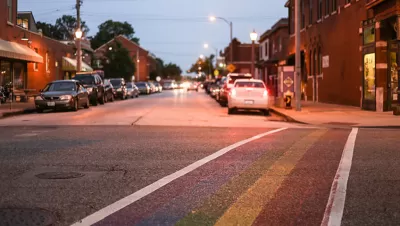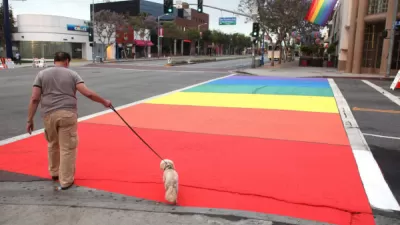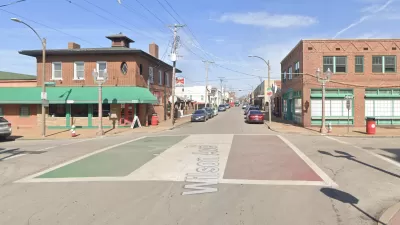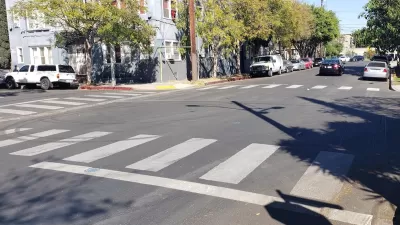St. Louis will end a program that allows groups to decorate crosswalks for the purposes of beautifying and branding neighborhoods. Currently decorated crosswalks can stay, for now.

"Say goodbye to the decorated fleur-de-lis and rainbow crosswalks that grace some intersections in St. Louis," reports Kristen Taketa. "The city now prohibits such crosswalk art projects, and the ones that exist will be left to fade away."
The sudden resistance to the city's painted crosswalks is credited to a 2011 Federal Highway Administration (FHWA) policy that says colorful crosswalks pose a danger. Taketa quotes directly from the policy, which says "crosswalk art is actually contrary to the goal of increased safety and most likely could be a contributing factor to a false sense of security for both motorists and pedestrians." According to the FHWA, problems could arise from misidentifying the borders of a crosswalk or from pedestrians who pause to gaze at the crosswalk.
Jamie Wilson, St. Louis bike/pedestrian coordinator, is also quoted in the article, assuring that none of the city's existing painted crosswalks will be removed "unless he learns they are actually causing problems." Wilson in quoted directly explaining the city's decision: "I don’t honestly believe someone’s going to trip over a fleur-de-lis crosswalk, but at the same time we want to be consistent with the memo the feds put out….It’s probably an ultra-conservative approach when it comes to safety, which is fine."
The reaction of the neighborhood groups that have already painted their crosswalks was disappointment—one in particular notes the unprecedented popularity of the crosswalks when compared to other forms of public art. According to Taketa, "Some groups, such as Tower Grove, still plan to put in more crosswalk art projects that fit within federal guidelines. That means using patterns with more 'natural' ground colors that distract less from the traditional white crosswalk lines."
FULL STORY: St. Louis will let crosswalk art that violates federal rules fade away

Planetizen Federal Action Tracker
A weekly monitor of how Trump’s orders and actions are impacting planners and planning in America.

Maui's Vacation Rental Debate Turns Ugly
Verbal attacks, misinformation campaigns and fistfights plague a high-stakes debate to convert thousands of vacation rentals into long-term housing.

San Francisco Suspends Traffic Calming Amidst Record Deaths
Citing “a challenging fiscal landscape,” the city will cease the program on the heels of 42 traffic deaths, including 24 pedestrians.

Amtrak Rolls Out New Orleans to Alabama “Mardi Gras” Train
The new service will operate morning and evening departures between Mobile and New Orleans.

The Subversive Car-Free Guide to Trump's Great American Road Trip
Car-free ways to access Chicagoland’s best tourist attractions.

San Antonio and Austin are Fusing Into one Massive Megaregion
The region spanning the two central Texas cities is growing fast, posing challenges for local infrastructure and water supplies.
Urban Design for Planners 1: Software Tools
This six-course series explores essential urban design concepts using open source software and equips planners with the tools they need to participate fully in the urban design process.
Planning for Universal Design
Learn the tools for implementing Universal Design in planning regulations.
Heyer Gruel & Associates PA
JM Goldson LLC
Custer County Colorado
City of Camden Redevelopment Agency
City of Astoria
Transportation Research & Education Center (TREC) at Portland State University
Jefferson Parish Government
Camden Redevelopment Agency
City of Claremont





























